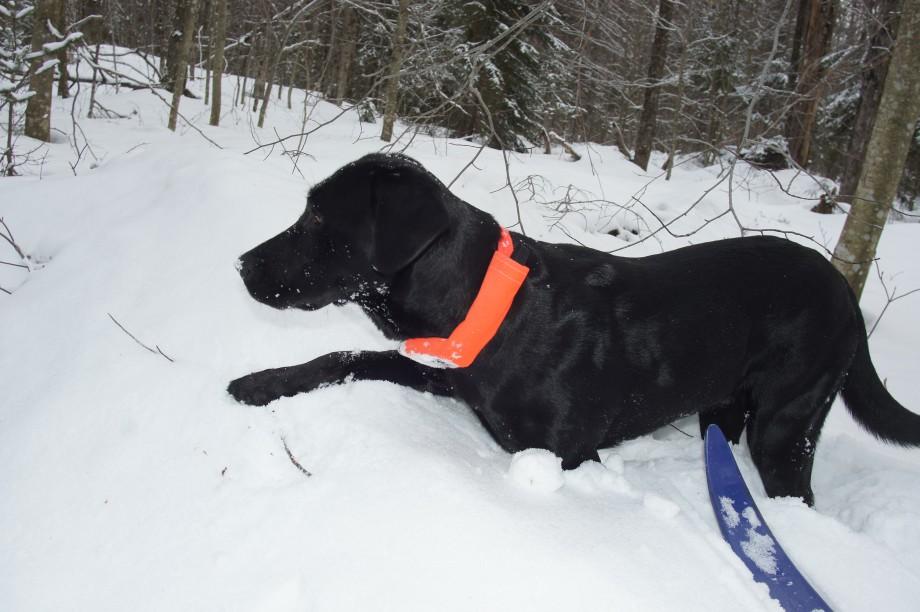
As we skied, I began to take notice of various animal tracks which intersected the trail. A coating of fresh powder had created a blank white canvas and animal artisans had painted their movements of the last day upon it.
In quick succession we found red squirrel, snowshoe hare, and ruffed grouse tracks – all common denizens of the northern forest. We also found fisher tracks, and the story of predator and prey in the woods was imprinted quite clearly despite looking at the abstraction of only their footprints. Fishers are large members of the weasel (mustelid) family, with adults weighing roughly 9-12 pounds, and are excellent hunters, famed for their ability to catch porcupines.
We turned onto the Fish Pond Truck Trail and continued looking as we skied. Hare and red squirrel tracks were everywhere our entire trip, and we soon added many white-tailed deer tracks to our growing list of species. Again we found fisher prints – perhaps left by the same individual. We would find fisher tracks several more times throughout the day.
The truck trail, which is no longer open to vehicles, is wide, making it a great skiing trail. It is about five miles long from the railroad tracks to the Fish Pond lean-to. Not quite halfway along the trail we ascended a large hill (that is always a fun ski) and raced and curved down the far side.
We skied on, making good progress on perfect trail conditions, adding a string of coyote tracks to our footprint menagerie. We later found a smaller set of canine tracks (other than the many dogs that run with skiers on the trails), that looked to be red fox as they tip-toed around logs, through patches of brush, crossed the trail, and then resumed their path through the woods.
Wren of course left her own tracks – which looked enormous as they spread out in the snow. Her large pads likely do help her stay afloat on the snow better than if she had small feet, but they are no match for many of the animals of the woods. After all, snowshoe hares are granted their name by their big feet. I would have post-holed past my knee if I had taken a step without my skis, but the hare tracks didn't sink in past the superficial snow on top.

Wren also finds looking at animal tracks to be a hobby we can all share, and she is good at finding tracks for us as she smells her way around the woods. In this way we found a line of mink tracks (in the classic weasel family hopping pattern) that wandered along the margins of a stream crossed by the trail, and admired their precision of jumps.
Not much farther along the trail we found a similar set of tracks in upland forest that I thought belonged to an American marten – another member of the weasel family and a great climber and hunter of red squirrels. However, in her zest for the smells, Wren raced through the snow with her nose on the ground leaving behind only her enormous tracks in their place, and we were left searching for the best marten tracks remaining. It is the mixed blessing of track hunting with Wren – she helps us find tracks, but then wipes them out in her enthusiasm.
After taking a short break for some food and chatting with some fellow dog skiers, we headed on, finally deciding to turn around about a mile from Fish Pond. Kendra and Wren turned first and I skied just a bit further to a low drainage and stream crossing. There in the snow of the stream banks were several sets of river otter tracks complete with their slides in the snow. They had even climbed into the dra

I turned happily to catch up and told Kendra the new addition to our snow canvas zoo. She as a tad disappointed she missed the otter tracks, but when on our return trip we took the trail that skirts Little Green Pond, she was reminded that she saw an otter on the ice of Little Green Pond a few weeks before. Sometimes we are lucky enough like she was to see wildlife. But more often we must decipher their comings and goings as we admire their patterns on a snowy canvas.





